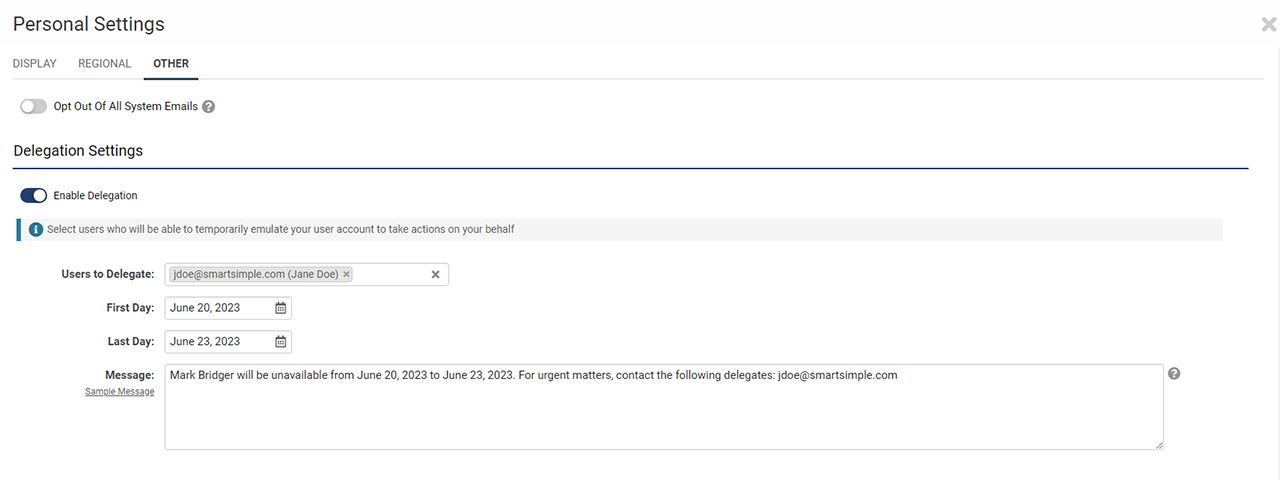Difference between revisions of "User Delegation"
Bankole Oni (talk | contribs) (→Configuration—Essentials) |
Bankole Oni (talk | contribs) (→Setting up the delegation) |
||
| Line 28: | Line 28: | ||
The delegate can then log in and see the delegation button, which allows them to emulate the user and perform tasks on their behalf. All actions taken by the delegate will be recorded in the audit logs. | The delegate can then log in and see the delegation button, which allows them to emulate the user and perform tasks on their behalf. All actions taken by the delegate will be recorded in the audit logs. | ||
| + | |||
| + | [[File:2023-07-ticket-143373-1.png|thumb|none|800px|Users with permission may go to personal settings and delegate to another user while they are out of office.]] | ||
| + | [[File:2023-07-ticket-143373-2.png|thumb|none|800px|Users may optionally enter an out of office message that will show up on their profile.]] | ||
| + | [[File:2023-07-ticket-143373-3.png|thumb|none|800px|If you have permission to temporarily emulate a specific user, you will see a new <strong>Delegation</strong> icon in the header. Select the specific user you would like to emulate.]] | ||
==Delegate Notification and Emulation== | ==Delegate Notification and Emulation== | ||
Revision as of 00:55, 25 June 2024
Contents
Overview
The delegation feature allows users to assign delegates who can emulate them within the system for a set period. This is useful for times when a user will be out of the office, such as for vacation, maternity leave, or other temporary absences. Users can select a delegate like a manager, co-worker, or colleague who can execute their tasks during their absence.
With this feature, there is no need to temporarily modify role permissions or assign other users to specific records. It is also not limited to internal users; external users such as applicants can designate a co-applicant to assist with their application process if allowed.
This article will show you how to setup and utilize SmartSimple’s User delegation functionality within your system.
Configuration—Essentials
Identifying which users can delegate to other users and users that can be delegated to
To enable Delegation for users of your system based on their roles, you must be a Global Administrator. Consider which roles in your system should have access to the User Delegation feature.
- Sign in as a global administrator and go to the global settings.
- Navigate to the security tab and select "System Feature Permissions".
- Go to the features tab to find delegation settings.
- Configure "Roles that can delegate" and "Roles to delegate to".
Note that global administrators can only delegate to other global administrators, and internal users can only delegate to other internal users. Additionally, this feature is not limited to internal users. External users, such as applicants, could designate a co-applicant to assist with the process of filling out an application on their behalf. Once a user is delegated, they will receive an email notification that they have been selected as a delegate. Once they login, the user will see a new icon in the global header that allows them to temporarily emulate another user.
Setting up the delegation
As an example, as a staff member going out of the office, you can delegate another user by following these steps:
- Select the user menu in the top right corner and click on the personal settings link.
- Go to the "Other" tab and toggle on "Enable Delegation".
- Select the user to delegate to by typing their email and selecting from the autocomplete options.
- Set the delegation period start and end dates.
- Optionally load a sample message to notify others of your out-of-office status.
- Click save to send the email notification to the delegate.
The delegate can then log in and see the delegation button, which allows them to emulate the user and perform tasks on their behalf. All actions taken by the delegate will be recorded in the audit logs.
Delegate Notification and Emulation
Once a user is delegated, the delegate will receive an email notification. Upon logging in, the delegate will see an icon in the global header to temporarily emulate the user. Below is an example of how this feature works:
Conclusion
This delegation feature in Smart Simple Cloud provides greater flexibility for managing out-of-office times.


